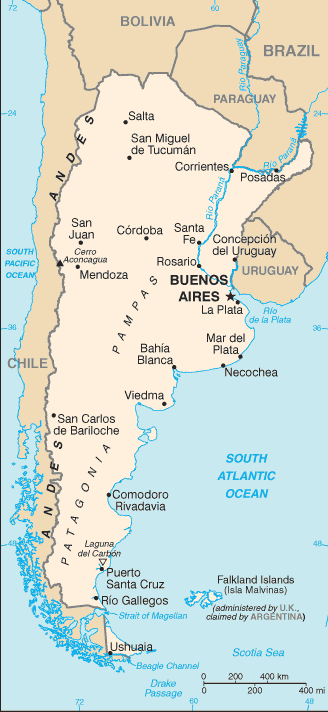 |
usa | world | animals | vocabulary | health | science | math | history |
Argentina

Map Courtesy CIA World Factbook
Argentina is a country in southern South America, situated between the Andes in the west and the southern Atlantic Ocean in the east. It is bordered by Paraguay and Bolivia in the north, Brazil and Uruguay in the northeast and Chile in the west. It's the second largest country of South America after Brazil and the 8th largest country in the world. The country is formally named República Argentina (pronunciation)? (Argentine Republic), while for purposes of legislation the form Nación Argentina (Argentine Nation) is used.
The name Argentina is derived from the Latin argentum (silver). The origin of this name goes back to the first voyages made by the Spanish conquerors to the River Plate. The survivors of the shipwrecked expedition mounted by Juan Díaz de Solís found indigenous people in the region who gave them silver objects as gifts. The news about the legendary Sierra del Plata – a mountain rich in silver – reached Spain around 1524. Since then, the Spaniards named the river of Solís, Río de la Plata (River of the Silver).
Europeans arrived in the region with the 1502 voyage of Amerigo Vespucci. Spanish navigator Juan Díaz de Solís visited what is now Argentina in 1516. Spain established a permanent colony on the site of Buenos Aires in 1580, although initial settlement was primarily overland from Peru. The Spanish further integrated Argentina into their empire by establishing the Viceroyalty of the Río de la Plata in 1776, and Buenos Aires became a flourishing port. Buenos Aires formally declared independence from Spain on July 9, 1816. Argentines revere Gen. José de San Martín, who campaigned in Argentina, Chile, and Peru as the hero of their national independence. Following the defeat of the Spanish, centralist and federationist groups waged a lengthy conflict between themselves to determine the future of the nation. National unity was established, and the constitution promulgated in 1853.
From 1880 to 1930 Argentina became one of the world's 10 wealthiest nations based on rapid expansion of agriculture and foreign investment in infrastructure. Conservative forces dominated Argentine politics until 1916, when their traditional rivals, the Radicals, won control of the government. The Radicals, with their emphasis on fair elections and democratic institutions, opened their doors to Argentina's rapidly expanding middle class as well as to groups previously excluded from power. The Argentine military forced aged Radical President Hipólito Yrigoyen from power in 1930 and ushered in another decade of Conservative rule. Using fraud and force when necessary, the governments of the 1930s attempted to contain the currents of economic and political change that eventually led to the ascendance of Juan Domingo Perón (b. 1895). New social and political forces were seeking political power, including a modern military and labor movements that emerged from the growing urban working class.
On October 30, 1983, Argentines went to the polls and chose Raúl Alfonsín, of the Radical Civic Union (UCR), as President. He began a 6-year term of office on December 10, 1983. In 1985 and 1987, large turnouts for mid-term elections demonstrated continued public support for a strong and vigorous democratic system. The UCR-led government took steps to resolve some of the nation's most pressing problems, including accounting for those who disappeared during military rule, establishing civilian control of the armed forces, and consolidating democratic institutions. However, failure to resolve endemic economic problems, and an inability to maintain public confidence undermined the effectiveness of the Alfonsín government, which left office 6 months early after Peronist candidate Carlos Saul Menem won the 1989 presidential elections.
In the first round of the presidential election on April 27, 2003, former President Carlos Menem (Partido Justicialista (PJ)) won 24.3% of the vote, Santa Cruz Governor Néstor Kirchner (PJ) won 22%, followed by the right-wing candidate Ricardo López Murphy with 16.4% and the center-left-wing Elisa Carrió with 14.2%. Menem withdrew from the May 25 runoff election after polls showed overwhelming support for Kirchner. The runoff election was not held and Mr. Kirchner took office as President on May 25, 2003.
This article is licensed under the GNU Free Documentation License. It uses material from the Wikipedia article "Africa".